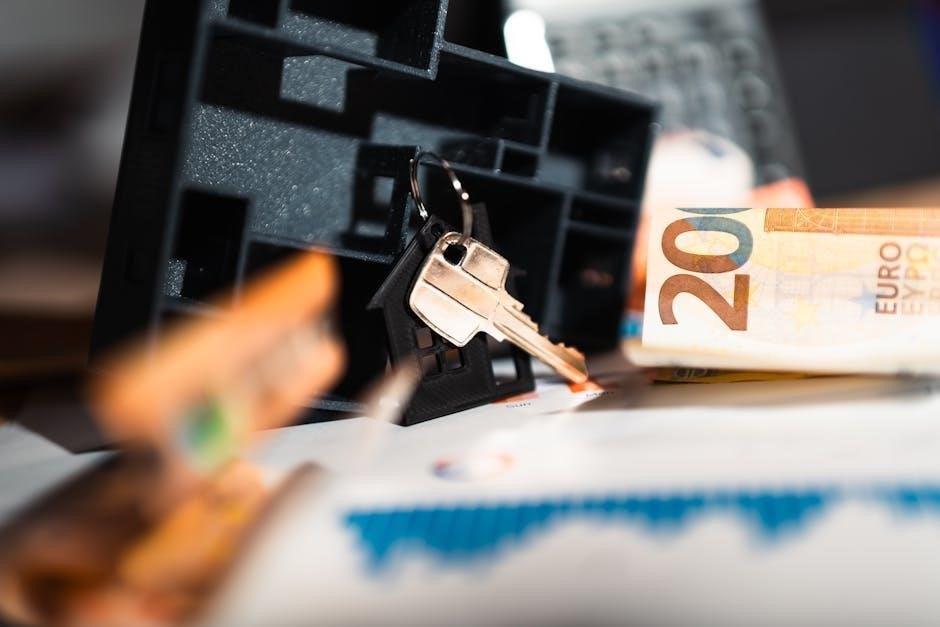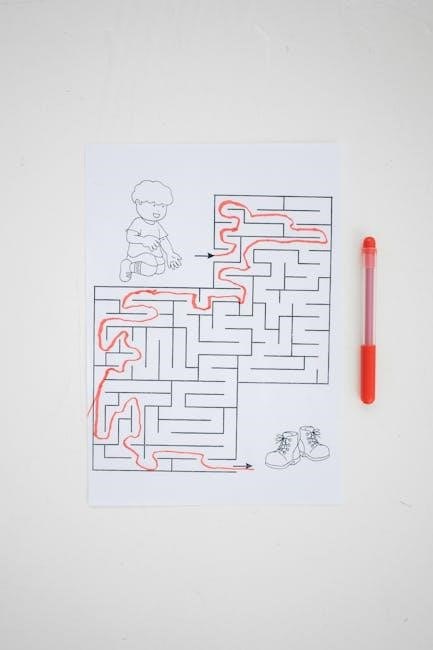A Sola Salon Lease Agreement is a legally binding contract between salon professionals and property owners, outlining terms for renting salon space. It ensures a smooth, professional relationship.
1.1 Definition and Purpose
A Sola Salon Lease Agreement is a legally binding contract between salon professionals and property owners, defining the terms for renting salon space. Its purpose is to outline rental fees, lease duration, and responsibilities of both parties, ensuring clarity and legal protection. This agreement is essential for establishing a professional relationship, preventing disputes, and providing a clear framework for salon operations. It serves as a formal document that safeguards the interests of both the lessor and lessee in the salon industry.
1.2 Importance of a Lease Agreement in the Salon Industry
A lease agreement is a cornerstone of the salon industry, ensuring clarity and legal protection for both salon owners and independent stylists. It prevents disputes by outlining rental fees, lease duration, and responsibilities. This document provides a clear framework for salon operations, protecting both parties’ interests. A well-drafted lease agreement fosters a professional relationship, reduces potential conflicts, and ensures compliance with legal standards, making it essential for the smooth operation of salon businesses.
Key Components of a Sola Salon Lease Agreement
A Sola Salon Lease Agreement includes essential elements like lessor and lessee details, property description, lease duration, rental terms, and responsibilities, ensuring clarity and legal compliance.
2.1 Lessor and Lessee Information
The Sola Salon Lease Agreement requires detailed identification of both the lessor (property owner) and lessee (tenant). This includes their full names, addresses, and contact information. Clearly stating the roles and identities of both parties ensures accountability and transparency. The agreement also specifies the purpose of the lease, such as operating a salon or renting a booth. Accurate and complete information is essential to avoid disputes and ensure a legally binding contract. This section forms the foundation of the agreement.
2.2 Property Description and Address
The Sola Salon Lease Agreement includes a detailed description of the leased property, such as the physical address, suite number, and specific area allocated for use. This section ensures clarity regarding the exact space being rented, preventing future disputes. The property description may also outline shared areas, equipment, or amenities included in the lease. Accurate documentation of the premises is crucial for both parties to understand their rights and responsibilities within the agreed-upon space.
2.3 Lease Duration and Type
The lease duration specifies the start and end dates of the agreement, while the type defines the terms, such as fixed rent or percentage-based rent. This section outlines whether the lease is month-to-month or for a fixed term, ensuring both parties understand the commitment. The lease type may also include options for renewal or termination, providing clarity on long-term arrangements. This clarity helps prevent disputes and ensures a stable business environment for salon professionals.
2.4 Rental Payment Schedule
The rental payment schedule outlines the due dates, accepted payment methods, and any late fees. It specifies whether the rent is fixed or percentage-based, ensuring clarity on financial obligations. This section also details grace periods or payment plans, if applicable. Clear terms help prevent disputes and ensure timely payments, maintaining a smooth relationship between the landlord and tenant. Proper documentation of the payment schedule is essential for accountability and transparency in the agreement.
2.5 Responsibilities of Both Parties
The lease agreement clearly outlines the responsibilities of both the landlord and tenant. The landlord is typically responsible for maintaining the property, handling major repairs, and ensuring compliance with local regulations. The tenant, or salon professional, is responsible for paying rent on time, maintaining their suite, and adhering to the agreed-upon terms. Both parties must communicate effectively and fulfill their obligations to ensure a harmonious and professional relationship throughout the lease term.
Types of Lease Agreements for Salon Suites
The primary types of lease agreements for salon suites are fixed rent and percentage rent. Fixed rent requires a set monthly payment, while percentage rent varies based on revenue.
3.1 Fixed Rent Lease
A fixed rent lease requires a set monthly payment, providing predictability for salon professionals. This type of lease ensures no rent increases during the initial term, typically the first 52 weeks. It appeals to those preferring financial stability, as the rental amount remains constant regardless of revenue fluctuations. This structure simplifies budgeting and offers clarity, making it a popular choice for salon suite rentals. The fixed rent model is straightforward, with no hidden variables affecting the payment amount.
3.2 Percentage Rent Lease
A percentage rent lease ties rental payments to a percentage of the lessee’s monthly gross revenue. This structure offers flexibility, as rent fluctuates with income, benefiting professionals with variable earnings. It is particularly advantageous for new or growing businesses, as it aligns expenses with revenue. However, it may result in higher payments during profitable periods. This lease type is less predictable than fixed rent but can be more equitable for both parties, reflecting the salon’s financial performance.
Benefits of a Sola Salon Lease Agreement
A Sola Salon Lease Agreement provides security for salon owners and flexibility for independent stylists, ensuring clear terms and legal protection for both parties, fostering a professional relationship.
4.1 Security for Salon Owners
A Sola Salon Lease Agreement provides salon owners with legal protection and clarity. It outlines property maintenance, rent payment terms, and liability clauses, ensuring owners are safeguarded against potential damages or financial losses. The agreement establishes a stable foundation, minimizing risks and ensuring compliance with agreed terms. This security allows salon owners to focus on their business operations with peace of mind, knowing their interests are protected.
4.2 Flexibility for Independent Stylists
A Sola Salon Lease Agreement offers independent stylists the flexibility to operate their businesses autonomously. It allows them to set their own schedules and pricing, giving them control over their professional environment. The agreement also provides the freedom to customize their salon suite according to their brand and client needs. This flexibility empowers stylists to build their businesses effectively, ensuring a balance between professional growth and personal satisfaction.

How to Create a Sola Salon Lease Agreement
Creating a Sola Salon Lease Agreement involves outlining terms, including names, addresses, lease duration, payment details, and responsibilities. Ensure legal review and signatures for validity.
5.1 Step-by-Step Guide to Formulating the Agreement
Formulating a Sola Salon Lease Agreement begins with identifying the lessor and lessee. Outline the property description, lease duration, and type. Specify rental payment schedules and responsibilities. Include terms for maintenance, repairs, and utilities. Define termination clauses and renewal options. Ensure compliance with local laws and regulations. Finally, conduct a legal review and obtain signatures from both parties to validate the agreement. This structured approach ensures clarity and protects both parties’ interests effectively.
5.2 Negotiation of Terms and Conditions
Negotiating a Sola Salon Lease Agreement involves discussing and finalizing terms mutually acceptable to both parties. Key areas include rental fees, lease duration, and responsibilities. Both the lessor and lessee should review and agree on clauses related to maintenance, repairs, and utilities. Legal counsel can assist in ensuring fair terms. Open communication helps address concerns, such as termination penalties or renewal options. A well-negotiated agreement fosters a positive and professional relationship, protecting both parties’ interests effectively.
5.3 Legal Review and Signatures
A thorough legal review of the Sola Salon Lease Agreement is essential to ensure compliance with local laws and protect both parties’ interests. Legal counsel should verify the document’s accuracy and fairness. Once both parties agree, signatures are obtained, finalizing the agreement. The lease becomes legally binding upon execution, with all terms enforceable. Proper documentation and witness signatures, if required, add authenticity to the contract, ensuring a smooth and professional partnership.
Common Mistakes to Avoid in Salon Lease Agreements
Common mistakes in salon lease agreements include hidden fees, unclear terms, and lack of legal consultation. These oversights can lead to financial and operational challenges.
6.1 Hidden Fees and Charges
Hidden fees in Sola Salon Lease Agreements can include unexpected costs like maintenance, utilities, or equipment rentals. These charges, if not clearly outlined, can lead to financial strain. It’s crucial to carefully review the agreement to identify any additional expenses beyond the base rent. Tenants should negotiate transparent terms to avoid surprises. Ensuring all fees are disclosed upfront prevents disputes and ensures a fair, mutually beneficial arrangement for both parties involved in the lease. Clarity is key to avoiding misunderstandings.
6.2 Unclear Terms and Conditions

Unclear terms in a Sola Salon Lease Agreement can lead to misunderstandings and disputes. Vague language regarding responsibilities, payment structures, or termination clauses may cause confusion. Tenants should ensure all terms are explicitly defined to avoid ambiguity. Clear conditions help prevent conflicts and ensure both parties understand their obligations. Ambiguous terms can lead to financial losses or legal issues, making it essential to seek clarification or legal advice before signing. Transparency in the agreement fosters trust and a smoother working relationship.
6.3 Lack of Legal Consultation
Not consulting a legal expert before signing a Sola Salon Lease Agreement can lead to overlooked clauses or unfavorable terms. Tenants may unknowingly accept hidden fees, unclear termination policies, or unrealistic obligations. Legal professionals can identify potential issues, ensuring the agreement is fair and protects both parties. Without proper legal review, salon professionals risk financial losses or legal disputes. It is crucial to seek professional advice to avoid long-term consequences and ensure the agreement aligns with their best interests.

Termination Clauses in Sola Salon Leases
Termination clauses in Sola Salon Leases outline the conditions and notice periods for ending the agreement. They specify penalties for early termination and renewal options, ensuring clarity and fairness for both parties.
7.1 Notice Periods for Termination
In a Sola Salon Lease Agreement, termination clauses specify the required notice periods for both parties. Typically, a 30 or 60-day written notice is mandatory before termination. This ensures both the salon owner and tenant have adequate time to prepare for the transition. The notice period may vary based on the agreement’s terms, but it is designed to maintain fairness and provide a clear framework for ending the lease without disputes.
7.2 Penalties for Early Termination
Penalties for early termination in a Sola Salon Lease Agreement are designed to protect the salon owner from financial losses. If a tenant terminates the lease before the agreed-upon term, they may face fees, such as a flat penalty or a proportion of remaining rent. For example, a $500 early termination fee or liability for unpaid rent until a new tenant is found. These penalties ensure both parties adhere to the contract and uphold their obligations.
7.3 Renewal Options and Conditions
Renewal options and conditions in a Sola Salon Lease Agreement outline the terms for extending the lease. Typically, either party must provide written notice within a specified period (e.g., 60 days) before the lease expires. Rent adjustments may occur upon renewal, often tied to market rates or predefined increases. The agreement may also include conditions for renewal, such as the lessee’s compliance with lease terms or the lessor’s approval. Renewal ensures continuity for both parties while allowing for necessary adjustments.
Amendments and Addendums to the Lease Agreement
Amendments and addendums to a Sola Salon Lease Agreement require written consent from both parties. They allow for modifications or additional terms, ensuring the agreement remains relevant and clear.
8.1 Process for Making Changes
To modify a Sola Salon Lease Agreement, changes must be proposed in writing by either party. The request is reviewed, and both parties must consent to the amendments. Once agreed upon, the changes are documented and incorporated into the lease. This ensures clarity and legal compliance, maintaining a fair and updated agreement for all involved.
8.2 Adding Additional Services or Equipment
Additions to the lease, such as extra services or equipment, require mutual agreement. Both parties must outline the terms, including costs and responsibilities, in a written addendum. This ensures all modifications are legally binding and clearly understood, preventing future disputes and maintaining a transparent relationship between the salon owner and the tenant.

Dispute Resolution in Salon Lease Agreements
Disputes are typically resolved through mediation or arbitration, as outlined in the agreement. Court proceedings may be necessary if alternative methods fail to reach a resolution.

9.1 Mediation and Arbitration
Mediation and arbitration are common methods for resolving disputes in salon lease agreements. Mediation involves a neutral third party facilitating negotiations between the salon owner and stylist. Arbitration, conversely, relies on a neutral decision-maker. Both processes aim to resolve conflicts without court intervention, preserving business relationships. These methods are often outlined in the lease agreement, ensuring a structured approach to addressing disagreements. They are cost-effective and efficient, providing a fair resolution for both parties involved in the salon lease agreement.
9.2 Court Proceedings
Court proceedings may be necessary when disputes arising from a Sola Salon Lease Agreement cannot be resolved through mediation or arbitration. This legal process involves filing a lawsuit, presenting evidence, and allowing a judge to make a binding decision. Court proceedings are typically a last resort, as they can be time-consuming and costly. However, they provide a formal and enforceable resolution, ensuring that the rights of both the salon owner and stylist are protected under the law.

Digital Execution of Sola Salon Lease Agreements
Digital execution simplifies the process of completing and signing Sola Salon Lease Agreements. Tools like pdfFiller and SignNow allow users to edit, highlight, and eSign documents efficiently, ensuring legality and convenience.
10.1 How to Fill Out the PDF Online
Filling out a Sola Salon Lease Agreement PDF online is straightforward. Upload the document to platforms like pdfFiller or SignNow. Use tools to edit, highlight, and add text. Fill in all required fields, including names, addresses, and lease terms. Review the document for accuracy. Electronically sign using a digital signature tool. Download or share the completed agreement securely. This method ensures efficiency, professionalism, and legal compliance, streamlining the leasing process for both parties.
10.2 Advantages of Digital Signatures
Digital signatures offer convenience, security, and efficiency for Sola Salon Lease Agreements. They eliminate the need for physical paperwork, allowing parties to sign documents remotely. Digital signatures are legally binding and tamper-proof, ensuring authenticity. Platforms like SignNow and pdfFiller enable easy e-signing, streamlining the leasing process. This method saves time, reduces errors, and provides a secure record of the agreement. It’s an eco-friendly and modern approach to finalizing salon lease agreements efficiently.

Why Choose Sola Salon Studios
Sola Salon Studios offers a reputable and reliable platform for salon professionals, providing customized suites, flexible lease terms, and exceptional support for independent stylists to thrive.
11.1 Reputation and Reliability
Sola Salon Studios has built a strong reputation as a trusted partner for salon professionals. With a history dating back to 1949, Sola is known for its commitment to quality and reliability. Their national leasing program and standardized agreements ensure consistency and fairness. Salon owners appreciate the transparent terms and professional support provided by Sola, making it a preferred choice for those seeking a secure and reputable salon space lease agreement.
11.2 Customized Salon Suites
Sola Salon Studios offers fully customizable salon suites tailored to meet the unique needs of each beauty professional. From design to equipment, stylists can personalize their space to reflect their brand and style. This flexibility allows for a professional environment that aligns with individual preferences, ensuring a seamless experience for both the stylist and their clients. The ability to customize enhances creativity and independence, making Sola a preferred choice for those seeking a personalized salon space.
11.3 Support for Independent Stylists
Sola Salon Studios provides comprehensive support for independent stylists, offering resources to help them succeed. From marketing assistance to client management tools, Sola empowers professionals to grow their businesses. The studio’s community-focused environment fosters collaboration and networking opportunities. Additionally, Sola’s flexible lease agreements and customizable spaces allow stylists to operate independently while benefiting from shared amenities. This support system enables stylists to focus on their craft, knowing they have a robust framework to support their entrepreneurial ventures and long-term success.

Case Studies and Examples
A successful stylist doubled their client base after signing a Sola Salon Lease Agreement, benefiting from customized terms and flexible lease options that supported their business growth effectively.
12.1 Successful Salon Lease Agreements
A successful Sola Salon Lease Agreement enabled a stylist to double their client base by offering flexible terms and customized salon spaces. The agreement provided legal protection and clear expectations, fostering a thriving business environment. Such examples highlight how well-structured lease agreements can support growth and stability for salon professionals, ensuring mutually beneficial outcomes for both parties involved in the salon suite rental process.
12.2 Lessons Learned from Real-World Scenarios
Real-world scenarios highlight the importance of clear terms in Sola Salon Lease Agreements. One stylist faced disputes due to unclear rental clauses, emphasizing the need for detailed agreements. Another case showed that well-defined responsibilities prevented misunderstandings. These examples underscore the value of legal reviews and open communication. By learning from such experiences, salon professionals can avoid common pitfalls and ensure smoother operations, ultimately benefiting both parties involved in the lease agreement.

Conclusion
A Sola Salon Lease Agreement is a cornerstone for secure and professional salon operations, protecting both parties’ interests. Use it to ensure clarity and mutual understanding.
13.1 Final Thoughts on Sola Salon Lease Agreements
A Sola Salon Lease Agreement is a cornerstone for secure and professional salon operations. It protects both salon owners and independent stylists by outlining clear terms, responsibilities, and expectations. This legally binding document ensures a smooth working relationship, providing clarity on rental fees, lease duration, and occupancy rights. By using a Sola Salon Lease Agreement, both parties can avoid disputes and focus on growing their businesses successfully. It is an essential tool for maintaining professionalism and legal compliance in the salon industry.
13.2 Encouragement to Use the Agreement
Using a Sola Salon Lease Agreement is highly recommended for salon professionals seeking a secure and organized framework. It provides legal protection, clarity, and professionalism, ensuring both parties understand their roles and responsibilities. By adopting this agreement, salon owners and stylists can avoid disputes, maintain a positive working relationship, and focus on growing their businesses. It is a vital tool for establishing trust and ensuring long-term success in the salon industry.






























